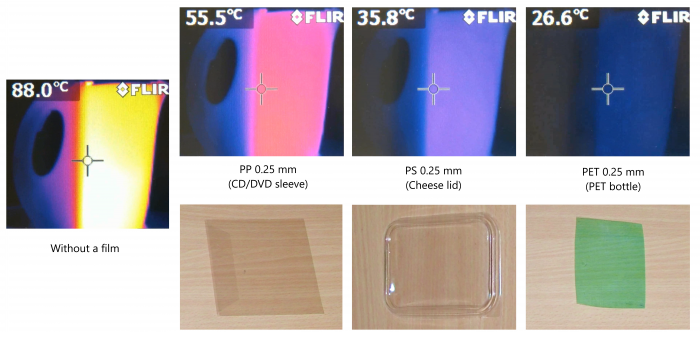Transmission of Thermal Radiation Through Plastic
Experiment number : 4349
Goal of experiment
The experiment aims to use a thermal imaging camera to demonstrate infrared radiation transmission of different plastic films – specifically, polypropylene (PP), polystyrene (PS) and polyethylene terephthalate (PET) films.
Equipment
Thermal imaging camera, micrometer scale, films of the same thickness made of different plastic materials, monitored object with a constant temperature higher than room temperature (e.g. a kettle with continuously boiling water).
In this particular experiment, films made of the following everyday objects were used:
- CD/DVD sleeve (polypropylene)
- cheese lid (polystyrene)
- PET bottle (polyethylene terephthalate)
Procedure
Using a micrometer scale, we select plastic films of different materials that have the same thickness; in our particular experiment, it was 0.25 mm.
We fix the thermal imaging camera so that it captures the object of noticeably different temperature compared to its surroundingsfilms between the camera and the selected object and watch how the image captured by the camera changes. The more the original image is attenuated and the measured temperature is closer to room temperature, the more thermal infrared radiation has been absorbed by the film.
Sample result
Successful implementation of the experiment is illustrated in Figure 1 below, which compares the images obtained by the thermal imaging camera when a film is placed between the camera and a hot object. It can be seen that, of the three materials compared, polyethylene terephthalate absorbs the most radiation and polypropylene the least.
To take the IR pictures, the FLIR i7 thermal imaging camera was used. The temperature range of the colour scheme was set in the interval of 22 °C and 89 °C, the emissivity was ε = 0.95.
Technical notes
A fundamental factor that influences all thermographic measurements is the emissivity of the measured surface, in short its ability to absorb incident radiation. Objects with a low emissivity reflect a substantial part of the incident radiation and thus distort the thermographic measurement, which primarily observes the thermal radiation of the body, not the reflected radiation. Therefore, when selecting suitable samples for the experiment, plastics with low emissivity should be avoided; these are usually very shiny at first glance. We can also do a simple test – if we lean over the film, point a thermal imaging camera at it, and see that the film reflects our thermal image, it is not suitable for this experiment.
Another suitable plastic for comparison is plasticized polyethylene (PE-LD), which has even higher permeability than all the materials studied so far.
As a test object, a light bulb can be used instead of a kettle, but with the requirement that its temperature does not change significantly during the experiment. It is therefore advisable that the bulb should be lit for at least ten minutes prior the experiment, so that a dynamic thermal equilibrium between its surface and the surrounding air can be established.
In the sample experiment, films with the same thickness were chosen, but the experiment will give satisfactory results even if the thicknesses of the films slightly vary (e.g. up to 10% or 15% of the thickness).
If we are working with a double film (e.g. a CD/DVD cover), we consider its thickness to be the sum of the thicknesses of its two sides; for the purposes of this experiment, the effects that occur between these sides (multiple reflections, etc.) can be neglected.
Pedagogical notes
Often the most beneficial thing for students to learn in this experiment is that the materials around us react differently when electromagnetic radiation of different wavelengths passes through them, i.e. objects transparent in visible light are not necessarily transparent in other spectral regions and vice versa. For example, the experiment described above shows that PET, which is transparent in the visible region, is almost opaque to thermal infrared radiation. In contrast, coloured tissue packaging (PE-LD) transmits almost no light, but thermal infrared radiation passes through it only slightly attenuated. A similar investigation of common objects around us may be the subject of further experiments.
If we take multiple films of the same thickness of the same material, it can be shown that the amount of transmitted radiation decreases exponentially as we increase the number of films in its way; a quantitative study of this phenomenon is the subject of an experiment Absorption of Thermal Radiation by Plastic Filters.
If we want to look at the properties of plastics at a higher level (e.g. during seminar or at university level), we can relate their behaviour in the infrared to their absorption spectra.
Near-infrared transmittance of plastics
Transmittance can also be studied in infrared radiation of other wavelengths (with different results) – for example, in the near-infrared region we deal with wavelengths around 1 µm (i.e. an order of magnitude smaller than in the case of thermal radiation typical of room temperature objects). For example, Kamila Goldová’s article can be an inspiration for such an experiment: Experiments With Infrared Radiation (in Czech only) introduced in 2001 at the Physics Teachers’ Inventions Fair in Olomouc.
Thermal imaging camera basics - link to PDF
In this experiment, a thermographic measurement is used. The theory of thermography and basic recommendation and procedures that can help you obtain more accurate and undistorted results can be found in Experiments with thermal imaging camera (in Czech only).








